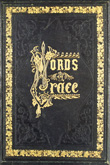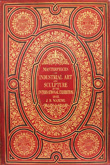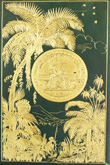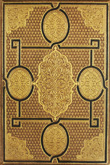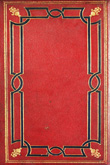Gold Tooling, Embossing, Stamping or Blocking. Which one is it?
Perhaps the most handsome way to finish a book is to embellish it in gold. On display in this cabinet are some of the finest examples of decorative leather and cloth bindings, each one tooled, embossed, stamped or blocked in gold. Finishing methods such as these vary greatly in their application but the final results can be difficult to discern. Can you spot the difference?
The gold leaf used to embellish books is actually gold alloy, small pieces of which are interleaved between thin paper and further enclosed within “gold-beaters skin” (usually parchment), before being beaten into leaf form. The “beating”, traditionally done by hand, is now mostly done by machine. The gold leaf is usually 22 or 23 Karat gold and is commonly sold in sheets or as a “book” of gold. A book of 25 sheets would cost approximately $80.00.
Gold tooling differs significantly from embossing, stamping and blocking as it is done with hand bookbinding finishing tools, not in an arming press. Bookbinders use tools such as ornaments, fillets, rolls, pallets or gouges (as seen in the cabinet alongside the Library's Imperial press) to first blind-tool the cloth or leather, creating a surface impression without any gold or ink. The area to be gold-tooled is then sized with a paste wash and glair (egg-albumen and vinegar or water) and once dry, a thin layer of “grease”, often olive oil, is applied, along with a layer of gold leaf. Tooling can then begin. The heated tools reactivate the glair and grease, causing the gold leaf to adhere whilst also coagulating the glair into a tough, insoluble adhesive. Any excess gold is then brushed away and residue grease is removed, usually with French chalk.
The terms “embossing” and “stamping” are often used interchangeably and although the results are similar, the methods used to achieve them are markedly different. During the embossing process a decoration or picture is impressed into the cloth or leather (via an embossing press) using a set of heated (usually brass or copper) male and female dies. The etched female die encounters the upper cloth or leather surface, whilst the male counter-die meets with it on the under-surface. Under pressure the cloth or leather is pushed up into the shape of the design, such that it stands out in relief. Debossing, as the name suggests, creates the opposite effect, whereby the lettering or image appears below the level of the book covering or, essentially, pressed into it. In stamping, the process is similar but a brass stamp, as opposed to metal dies, is used to create a pictorial or letter impression via an arming press. Gold leaf can then be applied to both embossed and stamped images in exactly the same way as it is in tooling.
Gold blocking is thought to have originated as early as the 16th Century when wooden blocks were used to impress gold into dampened leather via a screw-down press. The 1830s, however, saw the introduction of the Imperial arming press which could accommodate much larger brass dies and heat them with heating bars. Glair-treated cloth could then be blocked directly with gold leaf. This could be done before or, more frequently, after its attachment to the book board. Over the years, improvements in the blocking or arming press, including an increased platen size, have allowed for gold-blocking of both front and rear covers, plus entire spines. The first cloth book to be gold-blocked was Lord Byron’s Life and Works, published in 17 volumes, beginning in 1832.
In addition to gold-tooling, embossing, stamping and blocking, booksellers also use the terms “gilding” or “gilt” to describe a book’s decorative gold appearance. In fact, gilding usually relates to the process of applying gold to the page edges of a book. Here, the book (prior to covering) is clamped tightly in a press and its edges are ploughed, shaved or sanded until all pages are even in height and the whole surface is smooth. An adhesive, often containing bole (red clay) is then applied as a sealant and polished; glair, gelatin, or some other dilute size is next painted on the edges and, just before it dries, the gold leaf is laid on. Finally, when the mixture is completely dry, it is burnished with a gilder’s burnisher. The term all edges gilt (a.e.g.) is used to describe a book that has undergone gilding on all three sides. The purpose of the gilt edge (particularly the top edge) was not simply decorative. It served as a protective barrier from dust and dirt, making it easier to clean the page edges.
In cabinet 1, Sketches by Seymour, provides a fine example of both hand-tooled borders and debossed corner embellishments, whilst the six-compartment spine of The Great Civil War… is intricately blocked in gold. Relief (embossing) and gold stamping can be seen in this cabinet on Words of Grace, where the tell-tale signs of hand-tooling are evident in the cover border, where the gold pattern overlaps or fails to meet completely.

